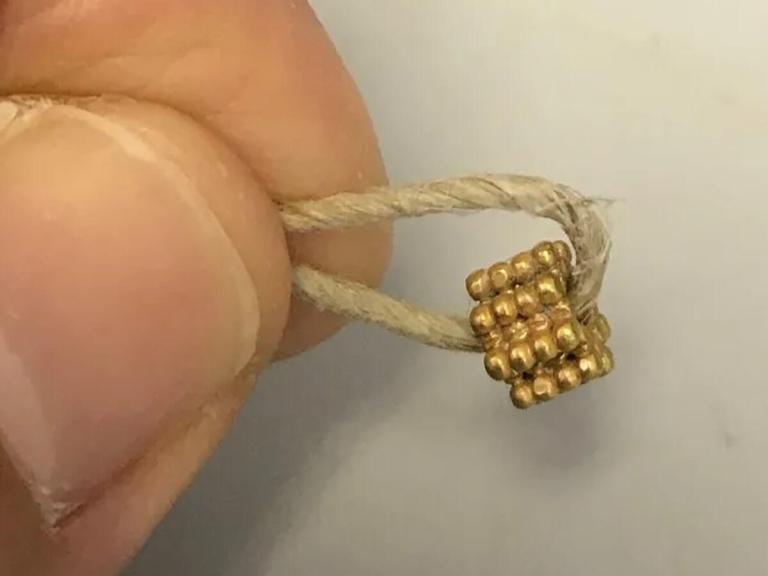
The Israel Antiquities Authority (IAA) recently revealed the discovery of a gold bead found in Emek Tzurim National Park. 18-year-old Hallel Feidman, a national service volunteer from Bnei Ayish, sifted the bead from dirt taken from excavations from the City of David along the Pilgrimage Road. Feidman said she had poured a pail of dirt into a sieve when “… I saw something shiny in the corner of the sieve – different – that I don’t normally see. I immediately approached the archaeologist, and he confirmed that I found a gold bead. Everyone here was very excited.” The bead is estimated to be at least 1600 years old, from the end of the Roman era in Israel. Gold is an extremely rare find, with ancient jewelry expert Amir Golani of the IAA declaring, “Throughout all my years in archaeology, I have found gold perhaps once or twice – so to find gold jewelry is something very, very special.”
The bead was most likely part of a necklace or bracelet and would have belonged to a very affluent individual. The bead is circular, with seven smaller gold balls welded together in the shape of a circle. The intricacy of the design dates back to a Mesopotamian technique developed 4500 years ago. Golani explained how that made the find even more unique, saying, “A good understanding of the materials and their properties is required, as well as control over the heat, in order to, on the one hand, solder the tiny balls together to create a tiny ring, while also preventing overheating which may lead all the gold to melt. Only a professional craftsman could produce such a bead, which is another reason that this find holds great value.” Eli Escusido, director of the Antiquities Authority, said that “Although it is a tiny find, it is precisely the personal, day-to-day items that manage to touch and connect us more than anything else, directly, to a certain person.” He added that such a technique would be difficult to accomplish even with modern technologies adding that, “A close examination of this object fills one with a deep sense of admiration for the technical skill and ability of those who came before us many centuries ago.”
The Pilgrimage Road, where the ring was excavated from, is an ancient Roman road that ran from the Temple Mount to the Pool of Siloam, the place where Jesus famously healed a blind man. At 1/3 of a mile long and 26 feet wide, the road is thought to have taken the Romans 10 years to build. The Romans used over 10,000 tons of limestone to complete it. National Geographic reported that historians had previously believed that King Herod the Great was behind many of the major building projects in ancient Jerusalem. However, after several coins dating from 31 AD were found beneath some of the road’s paving stones, the road is now believed to have been made during the days of Pontius Pilate. Zeev Orenstein, Director of International Affairs at the City of David Foundation, underscored the importance of the road. “The places and events and peoples that make Jerusalem, Jerusalem for Christians, for Jews, it all happened here. It happened here in the City of David. This is where the beating heart of Jerusalem is. We’re talking about the Pool of Siloam, we’re talking about Mt. Moriah, the Temple Mount. We’re talking about the City of David. The Pilgrimage Road links them all together.”


